[Editor’s Note: Mad Scientist Laboratory is pleased to present the first of two guest blog posts by Dr. Nir Buras. In today’s post, he makes the compelling case for the establishment of man-machine rules. Given the vast technological leaps we’ve made during the past two centuries (with associated societal disruptions), and the potential game changing technological innovations predicted through the middle of this century, we would do well to consider Dr. Buras’ recommended list of nine rules — developed for applicability to all technologies, from humankind’s first Paleolithic hand axe to the future’s much predicted, but long-awaited strong Artificial Intelligence (AI).]
Two hundred years of massive collateral impacts by technology have brought to the forefront of society’s consciousness the idea that some sort of rules for man-machine interaction are necessary, similar to the rules in place for gun safety, nuclear power, and biological agents. But where their physical effects are clear to see, the power of computing is veiled in virtuality and anthropomorphization. It appears harmless, if not familiar, and it often has a virtuous appearance.

Computing originated in the punched cards of Jacquard looms early in the 19th century. Today it carries the promise of a cloud of electrons from which we make our Emperor’s New Clothes. As far back as 1842, the brilliant mathematician Ada Augusta, Countess of Lovelace (1815-1852), foresaw the potential of computers. A protégé and associate of Charles Babbage (1791-1871), conceptual originator of the programmable digital computer, she realized the “almost incalculable” ultimate potential of such difference engines. She also recognized that, as in all extensions of human power or knowledge, “collateral influences” occur.1
AI presents us with such “collateral influences.”2 The question is not whether machine systems can mimic human abilities and nature, but when. Will the world become dependent on ungoverned algorithms?3 Should there be limits to mankind’s connection to machines? As concerns mount, well-meaning politicians, government officials, and some in the field are trying to forge ethical guidelines to address the collateral challenges of data use, robotics, and AI.4
A Hippocratic Oath of AI?

Asimov’s Three Laws of Robotics are merely a literary ploy to infuse his storylines.5 In the real world, Apple, Amazon, Facebook, Google, DeepMind, IBM, and Microsoft, founded www.partnershiponai.org6 to ensure “… the safety and trustworthiness of AI technologies, the fairness and transparency of systems.” Data scientists from tech companies, governments, and nonprofits gathered to draft a voluntary digital charter for their profession.7 Oren Etzioni, CEO of the Allen Institute for AI and a professor at the University of Washington’s Computer Science Department, proposed a Hippocratic Oath for AI.
But such codes are composed of hard-to-enforce terms and vague goals, such as using AI “responsibly and ethically, with the aim of reducing bias and discrimination.” They pay lip service to privacy and human priority over machines. They appear to sugarcoat a culture which passes the buck to the lowliest Soldier.8
We know that good intentions are inadequate when enforcing confidentiality. Well-meant but unenforceable ideas don’t meet business standards. It is unlikely that techies and their bosses, caught up in the magic of coding, will shepherd society through the challenges of the petabyte AI world.9 Vague principles, underwriting a non-binding code, cannot counter the cynical drive for profit.10
Indeed, in an area that lacks authorities or legislation to enforce rules, the Association for Computing Machinery (ACM) is itself backpedaling from its own Code of Ethics and Professional Conduct. Their document weakly defines notions of “public good” and “prioritizing the least advantaged.”11 Microsoft’s President Brad Smith admits that his company wouldn’t expect customers of its services to meet even these standards.
 In the wake of the Cambridge Analytica scandal, it is clear that coders are not morally superior to other people and that voluntary, unenforceable Codes and Oaths are inadequate.12 Programming and algorithms clearly reflect ethical, philosophical, and moral positions.13 It is false to assume that the so-called “openness” trait of programmers reflects a broad mindfulness. There is nothing heroic about “disruption for disruption’s sake” or hiding behind “black box computing.”14 The future cannot be left up to an adolescent-centric culture in an economic system that rests on greed.15 The society that adopts “Electronic personhood” deserves it.
In the wake of the Cambridge Analytica scandal, it is clear that coders are not morally superior to other people and that voluntary, unenforceable Codes and Oaths are inadequate.12 Programming and algorithms clearly reflect ethical, philosophical, and moral positions.13 It is false to assume that the so-called “openness” trait of programmers reflects a broad mindfulness. There is nothing heroic about “disruption for disruption’s sake” or hiding behind “black box computing.”14 The future cannot be left up to an adolescent-centric culture in an economic system that rests on greed.15 The society that adopts “Electronic personhood” deserves it.
Machines are Machines, People are People
 After 200 years of the technology tail wagging the humanity dog, it is apparent now that we are replaying history – and don’t know it. Most human cultures have been intensively engaged with technology since before the Iron Age 3,000 years ago. We have been keenly aware of technology’s collateral effects mostly since the Industrial Revolution, but have not yet created general rules for how we want machines to impact individuals and society. The blurring of reality and virtuality that AI brings to the table might prompt us to do so.
After 200 years of the technology tail wagging the humanity dog, it is apparent now that we are replaying history – and don’t know it. Most human cultures have been intensively engaged with technology since before the Iron Age 3,000 years ago. We have been keenly aware of technology’s collateral effects mostly since the Industrial Revolution, but have not yet created general rules for how we want machines to impact individuals and society. The blurring of reality and virtuality that AI brings to the table might prompt us to do so.
Distinctions between the real and the virtual must be maintained if the behavior of the most sophisticated computation machines and robots is captured by legal systems. Nothing in the virtual world should be considered real any more than we believe that the hallucinations of a drunk or drugged person are real.
The simplest way to maintain the distinction is remembering that the real IS, and the virtual ISN’T, and that virtual mimesis is produced by machines. Lovelace reminded us that machines are just machines. While in a dark, distant future, giving machines personhood might lead to the collapse of humanity, Harari’s Homo Deus warns us that AI, robotics, and automation are quickly bringing the economic value of humans to zero.16

From the start of civilization, tools and machines have been used to reduce human drudge labor and increase production efficiency. But while tools and machines obviate physical aspects of human work in the context of the production of goods or processing information, they in no way affect the truth of humans as sentient and emotional living beings, nor the value of transactions among them.

The man-machine line is further blurred by our anthropomorphizing machinery, computing, and programming. We speak of machines in terms of human traits, and make programming analogous to human behavior. But there is nothing amusing about GIGO experiments like MIT’s psychotic bot Norman, or Microsoft’s fascist Tay.17 Technologists falling into the trap of considering that AI systems can make decisions, are analogous to children, playing with dolls, marveling that “their dolly is speaking.”
Machines don’t make decisions. Humans do. They may accept suggestions made by machines and when they do, they are responsible for the decisions made. People are and must be held accountable, especially those hiding behind machines. The holocaust taught us that one can never say, “I was just following orders.”
Nothing less than enforceable operational rules is required for any technical activity, including programming. It is especially important for tech companies, since evidence suggests that they take ethical questions to heart only under direct threats to their balance sheets.18
 When virtuality offers experiences that humans perceive as real, the outcomes are the responsibility of the creators and distributors, no less than tobacco companies selling cigarettes, or pharmaceutical companies and cartels selling addictive drugs. Individuals do not have the right to risk the well-being of others to satisfy their need for complying with clichés such as “innovation,” and “disruption.”
When virtuality offers experiences that humans perceive as real, the outcomes are the responsibility of the creators and distributors, no less than tobacco companies selling cigarettes, or pharmaceutical companies and cartels selling addictive drugs. Individuals do not have the right to risk the well-being of others to satisfy their need for complying with clichés such as “innovation,” and “disruption.”
Nuclear, chemical, biological, gun, aviation, machine, and automobile safety rules do not rely on human nature. They are based on technical rules and procedures. They are enforceable and moral responsibility is typically carried by the hierarchies of their organizations.19
As we master artificial intelligence, human intelligence must take charge.20 The highest values known to mankind remains human life and the qualities and quantities necessary for the best individual life experience.21 For the transactions and transformations in which technology assists, we need simple operational rules to regulate the actions and manners of individuals. Moving the focus to human interactions empowers individuals and society.
Man-Machine Rules
Man-Machine rules should address any tool or machine ever made or to be made. They would be equally applicable to any technology of any period, from the first flaked stone, to the ultimate predictive “emotion machines.” They would be adjudicated by common law.22
 1. All material transformations and human transactions are to be conducted by humans.
1. All material transformations and human transactions are to be conducted by humans.
2. Humans may directly employ hand/desktop/workstation devices in the above.
3. At all times, an individual human is responsible for the activity of any machine or program.
4. Responsibility for errors, omissions, negligence, mischief, or criminal-like activity is shared by every person in the organizational hierarchical chain, from the lowliest coder or operator, to the CEO of the organization, and its last shareholder.
5. Any person can shut off any machine at any time.
6. All computing is visible to anyone [No Black Box].
7. Personal Data are things. They belong to the individual who owns them, and any use of them by a third-party requires permission and compensation.
8. Technology must age before common use, until an Appropriate Technology is selected.
9. Disputes must be adjudicated according to Common Law.
 Machines are here to help and advise humans, not replace them, and humans may exhibit a spectrum of responses to them. Some may ignore a robot’s advice and put others at risk. Some may follow recommendations to the point of becoming a zombie. But either way, Man-Machine Rules are based on and meant to support free, individual human choices.
Machines are here to help and advise humans, not replace them, and humans may exhibit a spectrum of responses to them. Some may ignore a robot’s advice and put others at risk. Some may follow recommendations to the point of becoming a zombie. But either way, Man-Machine Rules are based on and meant to support free, individual human choices.
Man-Machine Rules can help organize dialog around questions such as how to secure personal data. Do we need hardcopy and analog formats? How ethical are chips embedded in people and in their belongings? What degrees and controls are contemplatable for personal freedoms and personal risk? Will consumer rights and government organizations audit algorithms?23 Would equipment sabbaticals be enacted for societal and economic balances?
The idea that we can fix the tech world through a voluntary ethical code emergent from itself, paradoxically expects that the people who created the problems will fix them.24 It is not whether the focus should shift to human interactions that leaves more humans in touch with their destiny. The question is at what cost? If not now, when? If not by us, by whom?
If you reading enjoyed this post, please also see:
Prediction Machines: The Simple Economics of Artificial Intelligence
Artificial Intelligence (AI) Trends
Making the Future More Personal: The Oft-Forgotten Human Driver in Future’s Analysis
Nir Buras is a PhD architect and planner with over 30 years of in-depth experience in strategic planning, architecture, and transportation design, as well as teaching and lecturing. His planning, design and construction experience includes East Side Access at Grand Central Terminal, New York; International Terminal D, Dallas-Fort-Worth; the Washington DC Dulles Metro line; work on the US Capitol and the Senate and House Office Buildings in Washington. Projects he has worked on have been published in the New York Times, the Washington Post, local newspapers, and trade magazines. Buras, whose original degree was Architect and Town planner, learned his first lesson in urbanism while planning military bases in the Negev Desert in Israel. Engaged in numerous projects since then, Buras has watched first-hand how urban planning impacted architecture. After the last decade of applying in practice the classical method that Buras learned in post-doctoral studies, his book, *The Art of Classic Planning* (Harvard University Press, 2019), presents the urban design and planning method of Classic Planning as a path forward for homeostatic, durable urbanism.
1 Lovelace, Ada Augusta, Countess, Sketch of The Analytical Engine Invented by Charles Babbage by L. F. Menabrea of Turin, Officer of the Military Engineers, With notes upon the Memoir by the Translator, Bibliothèque Universelle de Genève, October, 1842, No. 82.
2 Oliveira, Arlindo, in Pereira, Vitor, Hippocratic Oath for Algorithms and Artificial Intelligence, Medium.com (website), 23 August 2018, https://medium.com/predict/hippocratic-oath-for-algorithms-and-artificial-intelligence-5836e14fb540; Middleton, Chris, Make AI developers sign Hippocratic Oath, urges ethics report: Industry backs RSA/YouGov report urging the development of ethical robotics and AI, computing.co.uk (website), 22 September 2017, https://www.computing.co.uk/ctg/news/3017891/make-ai-developers-sign-a-hippocratic-oath-urges-ethics-report; N.A., Do AI programmers need a Hippocratic oath?, Techhq.com (website), 15 August 2018, https://techhq.com/2018/08/do-ai-programmers-need-a-hippocratic-oath/
3 Oliveira, 2018; Dellot, Benedict, A Hippocratic Oath for AI Developers? It May Only Be a Matter of Time, Thersa.org (website), 13 February 2017, https://www.thersa.org/discover/publications-and-articles/rsa-blogs/2017/02/a-hippocratic-oath-for-ai-developers-it-may-only-be-a-matter-of-time; See also: Clifford, Catherine, Expert says graduates in A.I. should take oath: ‘I must not play at God nor let my technology do so’, Cnbc.com (website), 14 March 2018, https://www.cnbc.com/2018/03/14/allen-institute-ceo-says-a-i-graduates-should-take-oath.html; Johnson, Khari, AI Weekly: For the sake of us all, AI practitioners need a Hippocratic oath, Venturebeat.com (website), 23 March 2018, https://venturebeat.com/2018/03/23/ai-weekly-for-the-sake-of-us-all-ai-practitioners-need-a-hippocratic-oath/; Work, Robert O., former deputy secretary of defense, in Metz, Cade, Pentagon Wants Silicon Valley’s Help on A.I., New York Times, 15 March 2018.
4 Schotz, Mai, Should Data Scientists Adhere To A Hippocratic Oath?, Wired.com (website), 8 February 2018, https://www.wired.com/story/should-data-scientists-adhere-to-a-hippocratic-oath/; du Preez, Derek, MPs debate ‘hippocratic oath’ for those working with AI, Government.diginomica.com (website), 19 January 2018, https://government.diginomica.com/2018/01/19/mps-debate-hippocratic-oath-working-ai/
5 1. A robot may not injure a human being or, through inaction, allow a human being to come to harm. 2. A robot must obey the orders given it by human beings except where such orders would conflict with the First Law. 3. A robot must protect its own existence as long as such protection does not conflict with the First or Second Laws. Asimov, Isaac, Runaround, in I, Robot, The Isaac Asimov Collection ed., Doubleday, New York City, p. 40.
6 Middleton, 2017.
7 Etzioni, Oren, A Hippocratic Oath for artificial intelligence practitioners, Techcrunch.com (website), 14 March 2018. https://techcrunch.com/2018/03/14/a-hippocratic-oath-for-artificial-intelligence-practitioners/?platform=hootsuite
8 Do AI programmers need a Hippocratic oath?, Techhq, 2018.
9 Goodsmith, Dave, quoted in Schotz, 2018.
10 Schotz, 2018.
11 Do AI programmers need a Hippocratic oath?, Techhq, 2018. Wheeler, Schaun, in Schotz, 2018.
12 Gnambs, T., What makes a computer wiz? Linking personality traits and programming aptitude, Journal of Research in Personality, 58, 2015, pp. 31-34.
13 Oliveira, 2018.
14 Jarrett, Christian, The surprising truth about which personality traits do and don’t correlate with computer programming skills, Digest.bps.org.uk (website), British Psychological Society, 26 October 2015, https://digest.bps.org.uk/2015/10/26/the-surprising-truth-about-which-personality-traits-do-and-dont-correlate-with-computer-programming-skills/; Johnson, 2018.
15 Do AI programmers need a Hippocratic oath?, Techhq, 2018.
16 Harari, Yuval N. Homo Deus: A Brief History of Tomorrow. London: Harvill Secker, 2015.
17 That Norman suffered from extended exposure to the darkest corners of Reddit, and represents a case study on the dangers of artificial intelligence gone wrong when biased data is used in machine learning algorithms is not an excuse. AI Twitter bot, Tay had to be deleted after it started making sexual references and declarations such as “Hitler did nothing wrong.”
18 Schotz, 2018.
19 See the example of Dr. Kerstin Dautenhahn, Research Professor of Artificial Intelligence in the School of Computer Science at the University of Hertfordshire, who claims no responsibility in determining the application of the work she creates. She might as well be feeding children shards of glass saying, “It is their choice to eat it or not.” In Middleton, 2017. The principle is that the risk of an unfavorable outcome lies with an individual as well as the entire chain of command, direction, and or ownership of their organization, including shareholders of public companies and citizens of states. Everybody has responsibility the moment they engage in anything that could affect others. Regulatory “sandboxes” for AI developer experiments – equivalent to pathogen or nuclear labs – should have the same types of controls and restrictions. Dellot, 2017.
20 Oliveira, 2018.
21 Sentience and sensibilities of other beings is recognized here, but not addressed.
22 The proposed rules may be appended to the International Covenant on Economic, Social and Cultural Rights (ICESCR, 1976), part of the International Bill of Human Rights, which include the Universal Declaration of Human Rights (UDHR) and the International Covenant on Civil and Political Rights (ICCPR). International Covenant on Economic, Social and Cultural Rights, www.refworld.org.; EISIL International Covenant on Economic, Social and Cultural Rights, www.eisil.org; UN Treaty Collection: International Covenant on Economic, Social and Cultural Rights, UN. 3 January 1976; Fact Sheet No.2 (Rev.1), The International Bill of Human Rights, UN OHCHR. June 1996.
23 Dellot, 2017.
24 Schotz, 2018.



 Political and military actions directed at adversely impacting or defeating an opponent often entail clandestine operations which can be articulated across a spectrum that ranges from overt warfare to subtle “engagements.” Routinely, the United States, along with its allies (and adversaries), has employed clandestine tactics and operations across the kinetic and non-kinetic domains of warfare. Arguably, the execution of clandestine kinetic operations is employed more readily as these collective activities often occur after the initiation of conflict (i.e., “Right of Bang”), and their effects may be observed (to various degrees) and/or measured. Given that clandestine non-kinetic activities are less visible and insidious, they may be particularly (or more) effective because often they are unrecognized and occur “Left of Bang.” Other nations, especially adversaries, understand the relative economy of force that non-kinetic engagements enable and increasingly are focused upon developing and articulating advanced methods for operations.
Political and military actions directed at adversely impacting or defeating an opponent often entail clandestine operations which can be articulated across a spectrum that ranges from overt warfare to subtle “engagements.” Routinely, the United States, along with its allies (and adversaries), has employed clandestine tactics and operations across the kinetic and non-kinetic domains of warfare. Arguably, the execution of clandestine kinetic operations is employed more readily as these collective activities often occur after the initiation of conflict (i.e., “Right of Bang”), and their effects may be observed (to various degrees) and/or measured. Given that clandestine non-kinetic activities are less visible and insidious, they may be particularly (or more) effective because often they are unrecognized and occur “Left of Bang.” Other nations, especially adversaries, understand the relative economy of force that non-kinetic engagements enable and increasingly are focused upon developing and articulating advanced methods for operations. Much has been written about the fog of war. Non-kinetic engagements can create unique uncertainties prior to and/or outside of traditional warfare, precisely because they have qualitatively and quantitatively “fuzzy boundaries” as blatant acts of war. The “intentionally induced ambiguity” of non-kinetic engagements can establish plus-sum advantages for the executor(s) and zero-sum dilemmas for the target(s). For example, a limited scale non-kinetic action, which exerts demonstrably significant effects but does not meet defined criteria for an act of war, places the targeted recipient(s) at a disadvantage: First, in that the criteria for response (and proportionality) are vague and therefore any response could be seen as questionable; and second, in that if the targeted recipient(s) responds with bellicose action(s), there is considerable likelihood that they may be viewed as (or provoked to be) the aggressor(s) (and therefore susceptible to some form of retribution that may be regarded as sanctionable).
Much has been written about the fog of war. Non-kinetic engagements can create unique uncertainties prior to and/or outside of traditional warfare, precisely because they have qualitatively and quantitatively “fuzzy boundaries” as blatant acts of war. The “intentionally induced ambiguity” of non-kinetic engagements can establish plus-sum advantages for the executor(s) and zero-sum dilemmas for the target(s). For example, a limited scale non-kinetic action, which exerts demonstrably significant effects but does not meet defined criteria for an act of war, places the targeted recipient(s) at a disadvantage: First, in that the criteria for response (and proportionality) are vague and therefore any response could be seen as questionable; and second, in that if the targeted recipient(s) responds with bellicose action(s), there is considerable likelihood that they may be viewed as (or provoked to be) the aggressor(s) (and therefore susceptible to some form of retribution that may be regarded as sanctionable). Nominally, non-kinetic engagements often utilize non-military means to expand the effect-space beyond the conventional battlefield. The Department of Defense and Joint Staff do not have a well agreed-upon lexicon to define and to express the full spectrum of current and potential activities that constitute non-kinetic engagements. It is unfamiliar – and can be politically uncomfortable – to use non-military terms and means to describe non-kinetic engagements. As previously noted, it can be politically difficult – if not precarious– to militarily define and respond to non-kinetic activities.
Nominally, non-kinetic engagements often utilize non-military means to expand the effect-space beyond the conventional battlefield. The Department of Defense and Joint Staff do not have a well agreed-upon lexicon to define and to express the full spectrum of current and potential activities that constitute non-kinetic engagements. It is unfamiliar – and can be politically uncomfortable – to use non-military terms and means to describe non-kinetic engagements. As previously noted, it can be politically difficult – if not precarious– to militarily define and respond to non-kinetic activities.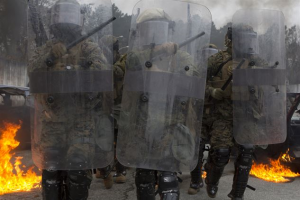 Non-kinetic engagements are best employed to incur disruptive effects in and across various dimensions of effect (e.g., biological, psychological, social) that can lead to intermediate to long-term destructive manifestations (in a number of possible domains, ranging from the economic to the geo-political). The latent disruptive and destructive effects should be framed and regarded as “Grand Strategy” approaches that evoke outcomes in a “long engagement/long war” context rather than merely in more short-term tactical situations.
Non-kinetic engagements are best employed to incur disruptive effects in and across various dimensions of effect (e.g., biological, psychological, social) that can lead to intermediate to long-term destructive manifestations (in a number of possible domains, ranging from the economic to the geo-political). The latent disruptive and destructive effects should be framed and regarded as “Grand Strategy” approaches that evoke outcomes in a “long engagement/long war” context rather than merely in more short-term tactical situations. Thus, non-kinetic operations must be seen and regarded as “tools of mass disruption,” incurring “rippling results” that can evoke both direct and indirect de-stabilizing effects. These effects can occur and spread: 1) from the cellular (e.g., affecting physiological function of a targeted individual) to the socio-political scales (e.g., to manifest effects in response to threats, burdens and harms incurred by individual and/or groups); and 2) from the personal (e.g., affecting a specific individual or particular group of individuals) to the public dimensions in effect and outcome (e.g., by incurring broad scale reactions and responses to key non-kinetic events).
Thus, non-kinetic operations must be seen and regarded as “tools of mass disruption,” incurring “rippling results” that can evoke both direct and indirect de-stabilizing effects. These effects can occur and spread: 1) from the cellular (e.g., affecting physiological function of a targeted individual) to the socio-political scales (e.g., to manifest effects in response to threats, burdens and harms incurred by individual and/or groups); and 2) from the personal (e.g., affecting a specific individual or particular group of individuals) to the public dimensions in effect and outcome (e.g., by incurring broad scale reactions and responses to key non-kinetic events). Given the increasing global stature, capabilities, and postures of Asian nations, it becomes increasingly important to pay attention to aspects of classical Eastern thought (e.g., Sun Tzu) relevant to bellicose engagement. Of equal importance is the recognition of various nations’ dedicated enterprises in developing methods of non-kinetic operations (e.g., China; Russia), and to understand that such endeavors may not comport with the ethical systems, principles, and restrictions adhered to by the United States and its allies.
Given the increasing global stature, capabilities, and postures of Asian nations, it becomes increasingly important to pay attention to aspects of classical Eastern thought (e.g., Sun Tzu) relevant to bellicose engagement. Of equal importance is the recognition of various nations’ dedicated enterprises in developing methods of non-kinetic operations (e.g., China; Russia), and to understand that such endeavors may not comport with the ethical systems, principles, and restrictions adhered to by the United States and its allies. These differing
These differing 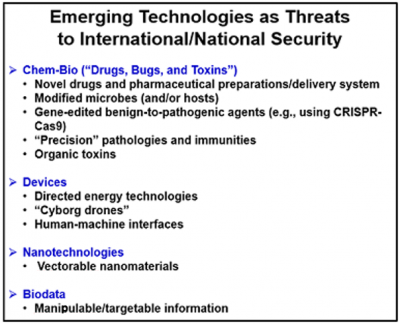 Table 1
Table 1 Of key interest are the present viability and current potential value of the
Of key interest are the present viability and current potential value of the As recent incidents (e.g., “Havana Syndrome”; use of novichok; infiltration of foreign-produced synthetic opioids to US markets) have demonstrated, the brain sciences and technologies have utility to affect “minds and hearts” in (kinetic and non-kinetic) ways that elicit biological, psychological, socio-economic, and political effects which can be clandestine, covert, or attributional, and which evoke multi-dimensional ripple effects in particular contexts (as previously discussed). Moreover, apropos current events, the use of
As recent incidents (e.g., “Havana Syndrome”; use of novichok; infiltration of foreign-produced synthetic opioids to US markets) have demonstrated, the brain sciences and technologies have utility to affect “minds and hearts” in (kinetic and non-kinetic) ways that elicit biological, psychological, socio-economic, and political effects which can be clandestine, covert, or attributional, and which evoke multi-dimensional ripple effects in particular contexts (as previously discussed). Moreover, apropos current events, the use of and/or selectively alter human susceptibility to disease
and/or selectively alter human susceptibility to disease Further, we opine that a coordinated enterprise of this magnitude will necessitate a Whole of Nations approach so as to mobilize the organizations, resources, and personnel required to meet other nations’ synergistic triple helix capabilities to develop and non-kinetically engage ETT.
Further, we opine that a coordinated enterprise of this magnitude will necessitate a Whole of Nations approach so as to mobilize the organizations, resources, and personnel required to meet other nations’ synergistic triple helix capabilities to develop and non-kinetically engage ETT.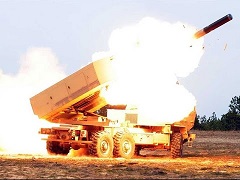
 “CAITT, let’s re-run the targeting solution for tomorrow’s engagement… again,” asked Chief Warrant Officer Five Robert Menendez, in a not altogether annoyed tone of voice. Considering this was the fifth time he had asked, the tone of control Bob was exercising was nothing short of heroic for those knew him well. Fortunately, CAITT, short for Commander’s Artificially Intelligent Targeting Tool, did not seem to notice. Bob quietly thanked the nameless software engineer who had not programmed it to recognize the sarcasm and vitriol that he felt when he made the request.
“CAITT, let’s re-run the targeting solution for tomorrow’s engagement… again,” asked Chief Warrant Officer Five Robert Menendez, in a not altogether annoyed tone of voice. Considering this was the fifth time he had asked, the tone of control Bob was exercising was nothing short of heroic for those knew him well. Fortunately, CAITT, short for Commander’s Artificially Intelligent Targeting Tool, did not seem to notice. Bob quietly thanked the nameless software engineer who had not programmed it to recognize the sarcasm and vitriol that he felt when he made the request. It was 0400 hours, and the entire Brigade Combat Team (BCT) was preparing to defend along its forward boundary. This after an exhausting three-day rapid deployment from their forward staging bases in Germany had everyone already on edge. In short, nothing had gone as expected or as planned for in the Operations Plan (OPLAN).
It was 0400 hours, and the entire Brigade Combat Team (BCT) was preparing to defend along its forward boundary. This after an exhausting three-day rapid deployment from their forward staging bases in Germany had everyone already on edge. In short, nothing had gone as expected or as planned for in the Operations Plan (OPLAN). The UBRA’s, short for Unified Belorussian Russian Alliance’s, 323rd Tank Division was a mere 68 kilometers from the BCT’s Forward Line of Troops or FLOT. They would be in the BCT’s primary engagement area in six hours. Between 1EU DIV and the EU’s Expeditionary Air Force’s efforts, nothing was slowing UBRA’s advance towards the critical seaport city of Gdansk, Poland.
The UBRA’s, short for Unified Belorussian Russian Alliance’s, 323rd Tank Division was a mere 68 kilometers from the BCT’s Forward Line of Troops or FLOT. They would be in the BCT’s primary engagement area in six hours. Between 1EU DIV and the EU’s Expeditionary Air Force’s efforts, nothing was slowing UBRA’s advance towards the critical seaport city of Gdansk, Poland. All the assumptions about air supremacy and cyber domination went out the window after the first UBRA tactical Electromagnetic Pulse (EMP) weapon detonated over Vilnius, Lithuania, 48 hours prior. A brilliant strategic move, the EMP fried every unshielded computer networked system the Allied Forces possessed. The Coalition AI Partner Network, so heavily relied on to execute the OPLAN, was inaccessible, as was every weapon system that linked to it. Right about now, Bob wished that CAITT was one of those systems.
All the assumptions about air supremacy and cyber domination went out the window after the first UBRA tactical Electromagnetic Pulse (EMP) weapon detonated over Vilnius, Lithuania, 48 hours prior. A brilliant strategic move, the EMP fried every unshielded computer networked system the Allied Forces possessed. The Coalition AI Partner Network, so heavily relied on to execute the OPLAN, was inaccessible, as was every weapon system that linked to it. Right about now, Bob wished that CAITT was one of those systems. “CAITT, that makes no sense!” Bob stated exasperatedly. “The 323rd has approximately 250 T-90 MBTs — even if they expend all their fuel and munitions in that 18 hours, they will still overrun our defensive positions in less than six. We only have a single armored battalion with 35 FMC LAV3s. Even if they meet 3-1 K-kill ratios, we will not be able to hold our position. If they dislodge the LAVs, the dismounted infantrymen won’t stand a chance. We need to target the C2 nodes of their lead tank regiment now with
“CAITT, that makes no sense!” Bob stated exasperatedly. “The 323rd has approximately 250 T-90 MBTs — even if they expend all their fuel and munitions in that 18 hours, they will still overrun our defensive positions in less than six. We only have a single armored battalion with 35 FMC LAV3s. Even if they meet 3-1 K-kill ratios, we will not be able to hold our position. If they dislodge the LAVs, the dismounted infantrymen won’t stand a chance. We need to target the C2 nodes of their lead tank regiment now with the M56s. If we can neutralize their centralized command and control and delay their rate of march, it may give the EUAF enough time to get us those CAS and AI sorties they promised,” replied Bob. “That’s the right play, space for time.”
the M56s. If we can neutralize their centralized command and control and delay their rate of march, it may give the EUAF enough time to get us those CAS and AI sorties they promised,” replied Bob. “That’s the right play, space for time.” now, airspace coordination is proceeding, and Colonel Ducalis is receiving his Commander’s Intervention Brief now. Pending his override there is nothing you can do.” CAITTs response almost sounded condescending to Bob; but then again, he remembered a time when human staff officers made recommendations to the boss, not smart-ass video game consoles.
now, airspace coordination is proceeding, and Colonel Ducalis is receiving his Commander’s Intervention Brief now. Pending his override there is nothing you can do.” CAITTs response almost sounded condescending to Bob; but then again, he remembered a time when human staff officers made recommendations to the boss, not smart-ass video game consoles.
 Bob entered the camo shield behind the JLTV constructing his argument to the boss in his mind. Colonel Ducalis had no time to entertain lengthy debate, this Bob knew. The fight was moving just too fast. Information is the currency of decision-making, and he would at best get about twenty seconds to make his case before something else grabbed the boss’s attention. CAITT would already be running the targeting solution straight to the boss via his Commanders Oculatory Device, jokingly called “COD,” referencing the old bawdy medieval term. Colonel Ducalis, already wearing the COD when Bob came in, was oblivious to everything else around him. Designed to construct a virtual and interactive battlefield environment, the COD worked almost
Bob entered the camo shield behind the JLTV constructing his argument to the boss in his mind. Colonel Ducalis had no time to entertain lengthy debate, this Bob knew. The fight was moving just too fast. Information is the currency of decision-making, and he would at best get about twenty seconds to make his case before something else grabbed the boss’s attention. CAITT would already be running the targeting solution straight to the boss via his Commanders Oculatory Device, jokingly called “COD,” referencing the old bawdy medieval term. Colonel Ducalis, already wearing the COD when Bob came in, was oblivious to everything else around him. Designed to construct a virtual and interactive battlefield environment, the COD worked almost  too well. Even as Bob came in, CAITT was constructing the virtual battlefield, displaying missile aimpoints, HIMARs firing positions, airspace coordination measures, and detailed damage predictions for the target areas.
too well. Even as Bob came in, CAITT was constructing the virtual battlefield, displaying missile aimpoints, HIMARs firing positions, airspace coordination measures, and detailed damage predictions for the target areas. “Sir, that is not correct,” Bob said speaking hurriedly. “We have a serious problem. CAITT’s targeting solution is completely wrong. The variables and assumptions were all predicated on the EUAF having air and cyber superiority. Those plans went out the window the second that EMP detonated. With all those aircraft down for CPU hardware replacement and software re-installs, those data points are now irrelevant. CAITT doesn’t know how long that will take because it is delinked from the Coalition’s AI Partner Network. I managed to get a low-frequency transmission established with Colonel Collins in Warsaw, and he thinks they can get us some sorties in the next six hours.
“Sir, that is not correct,” Bob said speaking hurriedly. “We have a serious problem. CAITT’s targeting solution is completely wrong. The variables and assumptions were all predicated on the EUAF having air and cyber superiority. Those plans went out the window the second that EMP detonated. With all those aircraft down for CPU hardware replacement and software re-installs, those data points are now irrelevant. CAITT doesn’t know how long that will take because it is delinked from the Coalition’s AI Partner Network. I managed to get a low-frequency transmission established with Colonel Collins in Warsaw, and he thinks they can get us some sorties in the next six hours.  CAITTs solution is ignoring the time versus space dynamic and going with a simple comparison of forces mathematical model. I’m betting it thinks that our casualties will be within acceptable limits after the 373rd expends all of its pre-staged consumable fuel and ammo. It thinks that we can hold our position if we cut off their re-supply. It may be right, but our losses will render us combat ineffective and unable to hold while 1EU DIV reconsolidates behind us.
CAITTs solution is ignoring the time versus space dynamic and going with a simple comparison of forces mathematical model. I’m betting it thinks that our casualties will be within acceptable limits after the 373rd expends all of its pre-staged consumable fuel and ammo. It thinks that we can hold our position if we cut off their re-supply. It may be right, but our losses will render us combat ineffective and unable to hold while 1EU DIV reconsolidates behind us.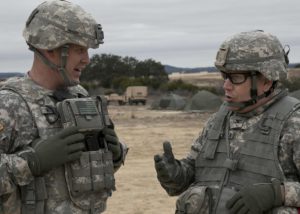 “We need to implement this High Payoff Target List and Attack Guidance immediately disrupting and attriting their lead maneuver formations. Sir, we need to play for time and space,” Bob explained, hoping the sports analogy resonated while simultaneously accessing his Fires Forearm Display or FFaD, transmitting the data to Duke’s COD with a wave of his hand.
“We need to implement this High Payoff Target List and Attack Guidance immediately disrupting and attriting their lead maneuver formations. Sir, we need to play for time and space,” Bob explained, hoping the sports analogy resonated while simultaneously accessing his Fires Forearm Display or FFaD, transmitting the data to Duke’s COD with a wave of his hand. Bob, realizing where this was going, took a knee next to Duke. He was clearly as tired as everyone else. Bob leaned in to speak while Duke started to review the new battlespace geometries and combat projections in his COD. “Duke,” Bob said in a low tone of voice so Major Atlee could not easily overhear him, “We’ve been friends a long time, I’ve never given you a bad recommendation. Please, override CAITT. LTC Givens can reposition his HIMARS battalion, but he has to start doing it now. This is our only chance; once those missiles are gone, we won’t get them back.”
Bob, realizing where this was going, took a knee next to Duke. He was clearly as tired as everyone else. Bob leaned in to speak while Duke started to review the new battlespace geometries and combat projections in his COD. “Duke,” Bob said in a low tone of voice so Major Atlee could not easily overhear him, “We’ve been friends a long time, I’ve never given you a bad recommendation. Please, override CAITT. LTC Givens can reposition his HIMARS battalion, but he has to start doing it now. This is our only chance; once those missiles are gone, we won’t get them back.” Larry, get a hold of 1EU DIV and tell them we can hold our positions for 24 hours. After that, we may have to withdraw, but we will live to fight another day. Right now, trading time for space may not be the optimal strategy, but it is the human one. Let’s Go!”
Larry, get a hold of 1EU DIV and tell them we can hold our positions for 24 hours. After that, we may have to withdraw, but we will live to fight another day. Right now, trading time for space may not be the optimal strategy, but it is the human one. Let’s Go!”
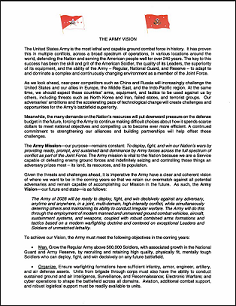 “The Army of 2028 will be ready to deploy, fight, and win decisively against any adversary, anytime and anywhere, in a joint, multi-domain, high-intensity conflict, while simultaneously deterring others and maintaining its ability to conduct irregular warfare. The Army will do this through the employment of modern manned and unmanned ground combat vehicles, aircraft, sustainment systems, and weapons, coupled with robust combined arms formations and tactics based on a modern warfighting doctrine and centered on exceptional Leaders and Soldiers of unmatched lethality.” GEN Mark A. Milley, Chief of Staff of the Army, and Dr. Mark T. Esper, Secretary of the Army, June 7, 2018.
“The Army of 2028 will be ready to deploy, fight, and win decisively against any adversary, anytime and anywhere, in a joint, multi-domain, high-intensity conflict, while simultaneously deterring others and maintaining its ability to conduct irregular warfare. The Army will do this through the employment of modern manned and unmanned ground combat vehicles, aircraft, sustainment systems, and weapons, coupled with robust combined arms formations and tactics based on a modern warfighting doctrine and centered on exceptional Leaders and Soldiers of unmatched lethality.” GEN Mark A. Milley, Chief of Staff of the Army, and Dr. Mark T. Esper, Secretary of the Army, June 7, 2018. In order to achieve this vision, the Army of 2028 needs a TRADOC 2028 that will recruit, organize, and train future Soldiers and Leaders to deploy, fight, and win decisively on any future battlefield. This TRADOC 2028 must account for: 1) the generational differences in learning styles; 2) emerging learning support technologies; and 3) how the Army will need to train and learn to maintain cognitive overmatch on the future battlefield. The Future Operational Environment, characterized by the speeding up of warfare and learning, will challenge the artificial boundaries between institutional and organizational learning and training (e.g., Brigade mobile training teams [MTTs] as a Standard Operating Procedure [SOP]).
In order to achieve this vision, the Army of 2028 needs a TRADOC 2028 that will recruit, organize, and train future Soldiers and Leaders to deploy, fight, and win decisively on any future battlefield. This TRADOC 2028 must account for: 1) the generational differences in learning styles; 2) emerging learning support technologies; and 3) how the Army will need to train and learn to maintain cognitive overmatch on the future battlefield. The Future Operational Environment, characterized by the speeding up of warfare and learning, will challenge the artificial boundaries between institutional and organizational learning and training (e.g., Brigade mobile training teams [MTTs] as a Standard Operating Procedure [SOP]). Soldiers will be “New Humans” – beyond digital natives, they will embrace embedded and integrated sensors, Artificial Intelligence (AI), mixed reality, and ubiquitous communications. “Old Humans” adapted their learning style to accommodate new technologies (e.g., Classroom XXI). New Humans’ learning style will be a result of these technologies, as they will have been born into a world where they code, hack, rely on intelligent tutors and expert avatars (think the nextgen of Alexa / Siri), and learn increasingly via immersive
Soldiers will be “New Humans” – beyond digital natives, they will embrace embedded and integrated sensors, Artificial Intelligence (AI), mixed reality, and ubiquitous communications. “Old Humans” adapted their learning style to accommodate new technologies (e.g., Classroom XXI). New Humans’ learning style will be a result of these technologies, as they will have been born into a world where they code, hack, rely on intelligent tutors and expert avatars (think the nextgen of Alexa / Siri), and learn increasingly via immersive  Delivering training for new, as of yet undefined MOSs and skillsets. The Army will have to compete with Industry to recruit the requisite talent for Army 2028. These recruits may enter service with fundamental technical skills and knowledges (e.g., drone creator/maintainer, 3-D printing specialist, digital and cyber fortification construction engineer) that may result in a flattening of the initial learning curve and facilitate more time for training “Green” tradecraft. Cyber recruiting will remain critical, as TRADOC will face an increasingly difficult recruiting environment as the Army competes to recruit new skillsets, from training deep learning tools to robotic repair. Initiatives to appeal to gamers (e.g., the Army’s
Delivering training for new, as of yet undefined MOSs and skillsets. The Army will have to compete with Industry to recruit the requisite talent for Army 2028. These recruits may enter service with fundamental technical skills and knowledges (e.g., drone creator/maintainer, 3-D printing specialist, digital and cyber fortification construction engineer) that may result in a flattening of the initial learning curve and facilitate more time for training “Green” tradecraft. Cyber recruiting will remain critical, as TRADOC will face an increasingly difficult recruiting environment as the Army competes to recruit new skillsets, from training deep learning tools to robotic repair. Initiatives to appeal to gamers (e.g., the Army’s  “TRADOC in your ruck.”
“TRADOC in your ruck.” 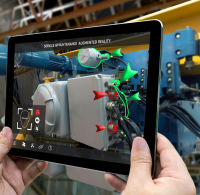 Learning in the future will be personalized and individualized with targeted learning at the point of need. Training must be customizable, temporally optimized in a style that matches the individual learners, versus a one size fits all approach. These learning environments will need to bring gaming and micro simulations to individual learners for them to experiment. Similar tools could improve tactical war-gaming and support Commander’s decision making. This will disrupt the traditional career maps that have defined success in the current generation of Army Leaders. In the future, courses will be much less defined by the rank/grade of the Soldiers attending them.
Learning in the future will be personalized and individualized with targeted learning at the point of need. Training must be customizable, temporally optimized in a style that matches the individual learners, versus a one size fits all approach. These learning environments will need to bring gaming and micro simulations to individual learners for them to experiment. Similar tools could improve tactical war-gaming and support Commander’s decision making. This will disrupt the traditional career maps that have defined success in the current generation of Army Leaders. In the future, courses will be much less defined by the rank/grade of the Soldiers attending them. Geolocation of Training will lose importance. We must stop building and start connecting. Emerging technologies – many accounted for in the
Geolocation of Training will lose importance. We must stop building and start connecting. Emerging technologies – many accounted for in the
 [Editor’s Note: Mad Scientist Laboratory is pleased to present our October edition of “The Queue” – a monthly post listing the most compelling articles, books, podcasts, videos, and/or movies that the U.S. Army’s Training and Doctrine Command (TRADOC) Mad Scientist Initiative has come across during the past month. In this anthology, we address how each of these works either informs or challenges our understanding of the Future Operational Environment. We hope that you will add “The Queue” to your essential reading, listening, or watching each month!]
[Editor’s Note: Mad Scientist Laboratory is pleased to present our October edition of “The Queue” – a monthly post listing the most compelling articles, books, podcasts, videos, and/or movies that the U.S. Army’s Training and Doctrine Command (TRADOC) Mad Scientist Initiative has come across during the past month. In this anthology, we address how each of these works either informs or challenges our understanding of the Future Operational Environment. We hope that you will add “The Queue” to your essential reading, listening, or watching each month!]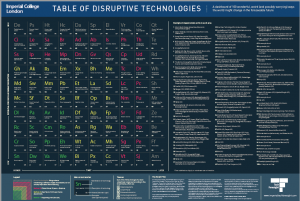 This innovative Table of Disruptive Technologies, derived from Chemistry’s familiar Periodic Table, lists 100 technological innovations organized into a two-dimensional table, with the x-axis representing Time (Sooner to Later) and the y-axis representing the Potential for Socio-Economic Disruption (Low to High). These technologies are organized into three time horizons, with Current (Horizon 1 – Green) happening now, Near Future (Horizon 2 – Yellow) occurring in 10-20 years, and Distant Future (Horizon 3 – Fuchsia) occurring 20+ years out. The outermost band of Ghost Technologies (Grey) represents fringe science and technologies that, while highly improbable, still remain within the realm of the possible and thus are “worth watching.” In addition to the time horizons, each of these technologies has been assigned a number corresponding to an example listed to the right of the Table; and a two letter code corresponding to five broad themes: DE – Data Ecosystems, SP – Smart Planet, EA – Extreme Automation, HA – Human Augmentation, and MI – Human Machine Interactions. Regular readers of the Mad Scientist Laboratory will find many of these
This innovative Table of Disruptive Technologies, derived from Chemistry’s familiar Periodic Table, lists 100 technological innovations organized into a two-dimensional table, with the x-axis representing Time (Sooner to Later) and the y-axis representing the Potential for Socio-Economic Disruption (Low to High). These technologies are organized into three time horizons, with Current (Horizon 1 – Green) happening now, Near Future (Horizon 2 – Yellow) occurring in 10-20 years, and Distant Future (Horizon 3 – Fuchsia) occurring 20+ years out. The outermost band of Ghost Technologies (Grey) represents fringe science and technologies that, while highly improbable, still remain within the realm of the possible and thus are “worth watching.” In addition to the time horizons, each of these technologies has been assigned a number corresponding to an example listed to the right of the Table; and a two letter code corresponding to five broad themes: DE – Data Ecosystems, SP – Smart Planet, EA – Extreme Automation, HA – Human Augmentation, and MI – Human Machine Interactions. Regular readers of the Mad Scientist Laboratory will find many of these Tim Berners-Lee, who created the World Wide Web in 1989, has said recently that he thinks his original vision is being distorted due to concerns about privacy, access, and fake news. Berners-Lee envisioned the web as a place that is free, open, and constructive, and for most of his invention’s life, he believed that to be true. However, he now feels that the web has undergone a change for the worse. He believes the World Wide Web should be a protected basic human right. In order to accomplish this, he has created the “
Tim Berners-Lee, who created the World Wide Web in 1989, has said recently that he thinks his original vision is being distorted due to concerns about privacy, access, and fake news. Berners-Lee envisioned the web as a place that is free, open, and constructive, and for most of his invention’s life, he believed that to be true. However, he now feels that the web has undergone a change for the worse. He believes the World Wide Web should be a protected basic human right. In order to accomplish this, he has created the “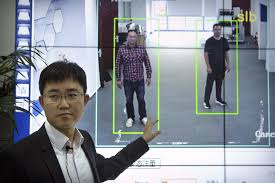
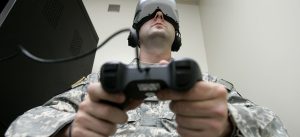 Tricking the brain can be fairly low tech, according to Dr. Alexis Mauger, senior lecturer at the University of Kent’s School of Sport and Exercise Sciences. Research has shown that students who participated in a
Tricking the brain can be fairly low tech, according to Dr. Alexis Mauger, senior lecturer at the University of Kent’s School of Sport and Exercise Sciences. Research has shown that students who participated in a  Presently, there are two predominant techniques for
Presently, there are two predominant techniques for  A European Union plan to tax internet firms like Google and Facebook on their turnover is on the verge of collapsing. As the plan must be agreed to by all 28 EU countries (a tall order given that it is opposed by a number of them), the EU is announcing national initiatives instead. The proposal calls for EU states to charge a 3 percent levy on the digital revenues of large firms. The plan aims at changing tax rules that have let some of the world’s biggest companies pay unusually low rates of corporate tax on their earnings. These firms, mostly from the U.S., are accused of averting tax by routing their profits to the bloc’s low-tax states.
A European Union plan to tax internet firms like Google and Facebook on their turnover is on the verge of collapsing. As the plan must be agreed to by all 28 EU countries (a tall order given that it is opposed by a number of them), the EU is announcing national initiatives instead. The proposal calls for EU states to charge a 3 percent levy on the digital revenues of large firms. The plan aims at changing tax rules that have let some of the world’s biggest companies pay unusually low rates of corporate tax on their earnings. These firms, mostly from the U.S., are accused of averting tax by routing their profits to the bloc’s low-tax states. In this article, subtitled “Are we designing inequality into our genes?” Ms. Hercher echoes what proclaimed Mad Scientist
In this article, subtitled “Are we designing inequality into our genes?” Ms. Hercher echoes what proclaimed Mad Scientist